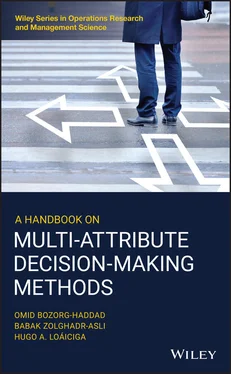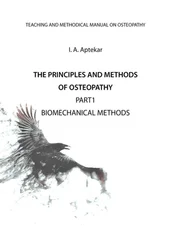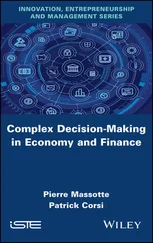Advisory Editors • Decision and Risk Analysis
Gilberto Montibeller,London School of Economics
Gregory S. Parnell,United States Military Academy at West Point
Founding Series Editor
James J. Cochran,University of Alabama
Analytics
Yang and Lee • Healthcare Analytics: From Data to Knowledge to Healthcare Improvement
Forthcoming Titles
Attoh‐Okine • Big Data and Differential Privacy: Analysis Strategies for Railway Track Engineering
Kong and Zhang • Decision Analytics and Optimization in Disease Prevention and Treatment
Decision and Risk Analysis
Barron • Game Theory: An Introduction, Second Edition
Bozorg‐Haddad, Zolghadr‐Asli, and Loáiciga • A Handbook on Multi‐Attribute Decision‐Making Methods
Brailsford, Churilov, and Dangerfield • Discrete‐Event Simulation and System Dynamics for Management Decision Making
Johnson, Keisler, Solak, Turcotte, Bayram, and Drew • Decision Science for Housing and Community Development: Localized and Evidence‐Based Responses to Distressed Housing and Blighted Communities
Mislick and Nussbaum • Cost Estimation: Methods and Tools
Forthcoming Titles
Aleman and Carter • Healthcare Engineering
Optimization Models
Ghiani, Laporte, and Musmanno • Introduction to Logistics Systems Management, Second Edition
Forthcoming Titles
Smith • Learning Operations Research Through Puzzles and Games
Tone • Advances in DEA Theory and Applications: With Examples in Forecasting Models
Stochastic Models
Ibe • Random Walk and Diffusion Processes
Forthcoming Titles
Donohue, Katok, and Leider • The Handbook of Behavioral Operations
Matis • Applied Markov Based Modelling of Random Processes
A Handbook on Multi‐Attribute Decision‐Making Methods
Omid Bozorg‐Haddad
University of Tehran
Alborz, Iran
Babak Zolghadr‐Asli
University of Tehran
Alborz, Iran
Hugo A. Loáiciga
University of California
Santa Barbara, United States

This edition first published 2021
© 2021 John Wiley and Sons, Inc.
All rights reserved. No part of this publication may be reproduced, stored in a retrieval system, or transmitted, in any form or by any means, electronic, mechanical, photocopying, recording or otherwise, except as permitted by law. Advice on how to obtain permission to reuse material from this title is available at http://www.wiley.com/go/permissions.
The right of Omid Bozorg‐Haddad, Babak Zolghadr‐Asli, and Hugo A. Loáiciga to be identified as the authors of this work has been asserted in accordance with law.
Registered Office
John Wiley & Sons, Inc., 111 River Street, Hoboken, NJ 07030, USA
Editorial Office
111 River Street, Hoboken, NJ 07030, USA
For details of our global editorial offices, customer services, and more information about Wiley products visit us at www.wiley.com.
Wiley also publishes its books in a variety of electronic formats and by print‐on‐demand. Some content that appears in standard print versions of this book may not be available in other formats.
Limit of Liability/Disclaimer of Warranty
While the publisher and authors have used their best efforts in preparing this work, they make no representations or warranties with respect to the accuracy or completeness of the contents of this work and specifically disclaim all warranties, including without limitation any implied warranties of merchantability or fitness for a particular purpose. No warranty may be created or extended by sales representatives, written sales materials or promotional statements for this work. The fact that an organization, website, or product is referred to in this work as a citation and/or potential source of further information does not mean that the publisher and authors endorse the information or services the organization, website, or product may provide or recommendations it may make. This work is sold with the understanding that the publisher is not engaged in rendering professional services. The advice and strategies contained herein may not be suitable for your situation. You should consult with a specialist where appropriate. Further, readers should be aware that websites listed in this work may have changed or disappeared between when this work was written and when it is read. Neither the publisher nor authors shall be liable for any loss of profit or any other commercial damages, including but not limited to special, incidental, consequential, or other damages.
Library of Congress Cataloging‐in‐Publication Data
Names: Bozorg-Haddad, Omid, 1974‐ author. | Zolghadr‐Asli, Babak, author. |
Loáiciga, Hugo A., author.
Title: A handbook on multi‐attribute decision‐making methods / Omid
Bozorg‐Haddad, Babak Zolghadr‐Asli, Hugo A. Loáiciga.
Description: Hoboken, NJ : Wiley, 2021. | Series: Wiley series in
operations research and management science | Includes bibliographical
references and index.
Identifiers: LCCN 2020034049 (print) | LCCN 2020034050 (ebook) | ISBN
9781119563495 (cloth) | ISBN 9781119563471 (adobe pdf) | ISBN
9781119563389 (epub) | ISBN 9781119563501 (obook)
Subjects: LCSH: Multiple criteria decision making.
Classification: LCC T57.95 .B69 2021 (print) | LCC T57.95 (ebook) | DDC
658.4/03–dc23
LC record available at https://lccn.loc.gov/2020034049
LC ebook record available at https://lccn.loc.gov/2020034050
Cover Design: Wiley
Cover Image: © connel/Shutterstock
Multi‐attribute decision‐making (MADM) problems describe a situation in which the decision‐makers evaluate a finite number of pre‐defined alternatives that are explicitly known at the beginning of the solution process with regard to a set of often conflictive evaluating criteria. It would not be an exaggeration to state that almost everyone, whether in their personal or professional life, faces decision‐making problems on a daily basis. Although there are numerous MADM methods at the decision‐makers’ disposal to cope with real‐world decision‐making problems there is still lacking a source that compiles and explains the various MADM methods in a clear and systematic manner that would make their understanding, comparison, and application straightforward for those who require implementing these techniques. Most existing sources that deal with MADM methods are generally focused on results of the applications of these methods, but overlook basic and unifying concepts. Therefore, those who are eager to gain an overview of these methods must endure hardships of searching through various sources which are written in specialized form and are difficult to understand.
The book at hand fills the cited knowledge and educational gap and describes the most important MADM methods, with an assessment of their performance in solving multiple problems encompassing many fields of inquiry and practice in a clear and systematic manner. The proposed book contains 12 chapters plus two appendices. Chapter 1provides an overview of the decision‐making and its fundamental concepts. Each of chapters 2through 12 is devoted to a separate MADM method. In total, some 20 MADM methods are presented in the book. Appendix I describes a weight assignment method; Appendix II contains an application of MADM methods. The chapters are arranged based on pedagogical purposes so that the audience can easily engage with the presented materials in each given chapter. Nevertheless, the basic idea is to ensure that each chapter can stand alone by providing the audience with a brief description of the materials and methods required to cover every aspect and mathematical concepts used in each given method. In other words, while a highly engaged audience can go through the entire book to gain a deep understanding of MADM methods and their theoretical foundation, some can aim at a specific chapter without facing any difficulty in understanding the materials presented for the reviewed MADM methods. In essence, each chapter describing a specific MADM method, or in some case a family of methods, starts with a brief literature review of the methods’ development followed by a description of its theoretical origins. The philosophical foundations of each method are discussed and mapped to the mathematical framework of the specified MADM method. Each chapter contains a stepwise description of its pertinent method that serves as the guideline for implementing the method with the purpose of coping with real‐world MADM problems.
Читать дальше













